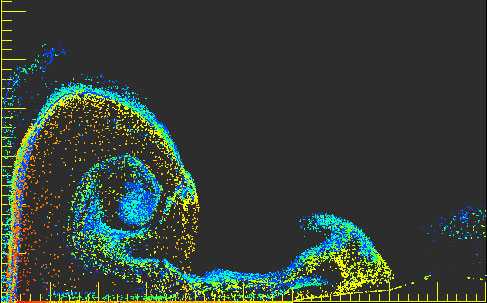Multiphase Magmatism:
From Crustal Construction
to Eruptive Dynamics
By:
Josef Dufek
Georgia Tech
| When: | Friday, November 16, 2012, 10:30 a.m. to 11:30 a.m. Join us for coffee beginning at 10:00 a.m. |
| Where: | Seminar Conference Room, 10100 Burnet Road, Bldg 196-ROC, Austin, Texas 78758 |
| Host: | Nick Hayman, UTIG |
Click for a Live Broadcast.

Abstract
Many processes in nature involve multiple, mechanically distinct phases: for instance, crystals settling in magmatic systems and ash particles interacting with a turbulent gas phase in an explosive volcanic eruptions. The interaction between these phases shape the landscape of all terrestrial planets, dictate interactions at the interface of the solid surface and the atmosphere and lead to the large scale differentiation of Earth and other planets.
Examples of multiphase flows include explosive volcanic eruptions, Martian dust storms, sediment-choked rivers, crystal and bubble-laden magma chambers and marine turbidity currents. Although extremely common, the cumulative expression of numerous particle-particle and particle-fluid interactions can produce emergent meso-scale structure and self-organization that is difficult to predict.
I will discuss the use of multiphase models in addressing the different scales of fluid motion in magmatic multiphase flow as well as how they can provide a platform to integrate microphysical, analogue experiments and observational constraints. Microphysical experiments can provide the necessary closure for statistical mechanics based models, and provide a way to examine grain-scale processes in a probabilistic manner. Such small-scale processes can dramatically alter the flow dynamics.
One of the primary goals and utilities of this combined approach is that it enables comparison with diverse datasets, integrating previously disparate observations. In this talk I will illustrate three types of comparison that cover very different dynamic ranges and observation types. Compositional gaps, or 'Daly Gaps' in magmatic series have long been recognized, and here I will discuss the use of a combined multiphase dynamics and thermodynamics approach to predict the probability of gaps forming in different magmatic environments. These dynamics can be used to explain geochemical trends in individual magmatic environments as well as broader trends in the vertical structure of the crust. Higher in the crustal column, the high energy density of volcanic conduits can cause particles to break above the traditionally defined fragmentation front. This style of break-up or, granular disruption can have a first-order control on the textures and sizes of particles exiting the vent providing a link between deposits and subsurface dynamics. Importantly granular disruption also strongly influences the dynamics and amount of fine-grained ash that can be injected into the atmosphere. Finally I will discuss experiments and numerical calculations used to link processes in eruptive plumes to satellite observations and deposits. By using an integrated lab, field and numerical modeling approach we can better describe near-field plume sources of ash, one of the biggest sources of error in current dispersal forecasts such as those associated with the eruption of Eyjafjallajökull, and provide an understanding of the microphysics necessary to interpret the next generation of in situ measurements including concentration and electric fields.




